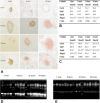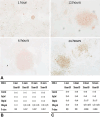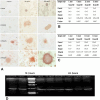In vitro effects of heparin-binding epidermal growth factor on adhesion stage of implantation
- PMID: 38184829
- PMCID: PMC10863694
- DOI: 10.47162/RJME.64.4.05
In vitro effects of heparin-binding epidermal growth factor on adhesion stage of implantation
Abstract
A member of the epidermal growth factor (EGF) family, the heparin-binding EGF (HB-EGF) is expressed in the uteri of both humans and mice during the implantation process. To study the effects of HB-EGF on adhesion stage, we developed an in vitro implantation model employing Ishikawa cell line and JAR cell line, which may attach to Ishikawa cells. For 1, 6, 12, and 24 hours, co-cultures of JAR spheroids grown on Ishikawa monolayers were treated with 1, 10, and 100 ng∕mL doses of HB-EGF. Using immunocytochemistry and Western blot analysis, the effects of HB-EGF on the protein expressions of E-cadherin, Erb-B2 receptor tyrosine kinase 4 (ErbB4), and integrin ανβ3 in Ishikawa and JAR cells were examined semi-quantitatively and quantitatively. Ultrastructural changes of in vitro implantation model were investigated by transmission electron microscopy. We revealed that HB-EGF influenced trophoblast cell adhesion to endometrial cells by upregulating the expression of the proteins ErbB4 and trophoblastic integrin ανβ3. Decrease in trophoblastic E-cadherin expression and increase in endometrial E-cadherin expression were demonstrated accompanying morphological variations in cells required for the invasion. We discovered ultrastructurally that Ishikawa cells acquired uterodome-like appearance, including the organelles, when 10 and 100 ng∕mL dosages of HB-EGF were administered for 12 and 24 hours. However, following additional hours of adhesion and invasion, their intercellular spaces enlarged. The trafficking of vesicular transport was enhanced by JAR spheroids. We therefore discovered that in this implantation paradigm, HB-EGF may enhance the receptivity of Ishikawa cells and the adherence of JAR cells.
Conflict of interest statement
The authors declare that they have no conflict of interests.
Figures






Similar articles
-
Heparin-binding epidermal growth factor (HB-EGF) may improve embryonic development and implantation by increasing vitronectin receptor (integrin alphanubeta3) expression in peri-implantation mouse embryos.J Assist Reprod Genet. 2006 Mar;23(3):111-9. doi: 10.1007/s10815-006-9021-9. Epub 2006 Apr 19. J Assist Reprod Genet. 2006. PMID: 16622802 Free PMC article.
-
Acceleration of trophoblast differentiation by heparin-binding EGF-like growth factor is dependent on the stage-specific activation of calcium influx by ErbB receptors in developing mouse blastocysts.Development. 2000 Jan;127(1):33-44. doi: 10.1242/dev.127.1.33. Development. 2000. PMID: 10654598
-
Heparin-binding EGF-like growth factor interacts with mouse blastocysts independently of ErbB1: a possible role for heparan sulfate proteoglycans and ErbB4 in blastocyst implantation.Development. 1999 May;126(9):1997-2005. doi: 10.1242/dev.126.9.1997. Development. 1999. PMID: 10101133
-
Role of membrane-bound heparin-binding epidermal growth factor-like growth factor (HB-EGF) in renal epithelial cell branching.Kidney Int. 2002 Jun;61(6):1968-79. doi: 10.1046/j.1523-1755.2002.00358.x. Kidney Int. 2002. PMID: 12028437
-
Heparin-binding EGF-like growth factor.Biochim Biophys Acta. 1997 Dec 9;1333(3):F179-99. doi: 10.1016/s0304-419x(97)00024-3. Biochim Biophys Acta. 1997. PMID: 9426203 Review.
References
-
- Weimar CHE, Uiterweer EDP, Teklenburg G, Heijnen CJ, Macklon NS. In-vitro model systems for the study of human embryo-endometrium interactions. Reprod Biomed Online. 2013;27(5):461–476. - PubMed
-
- Mardon H, Grewal S, Mills K. Experimental models for investigating implantation of the human embryo. Semin Reprod Med. 2007;25(6):410–417. - PubMed
-
- Zhao HB, Wang C, Li RX, Tang CL, Li MQ, Du MR, Hou XF, Li DJ. E-cadherin, as a negative regulator of invasive behavior of human trophoblast cells, is down-regulated by cyclosporin A via epidermal growth factor/extracellular signal-regulated protein kinase signaling pathway. Biol Reprod. 2010;83(3):370–376. - PubMed
MeSH terms
Substances
LinkOut - more resources
Full Text Sources
Research Materials
Miscellaneous

